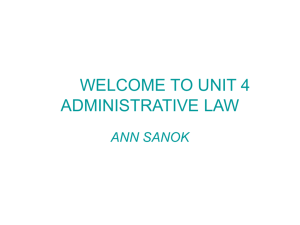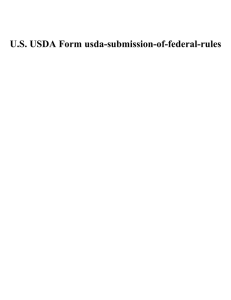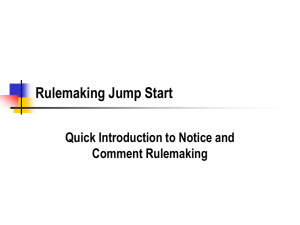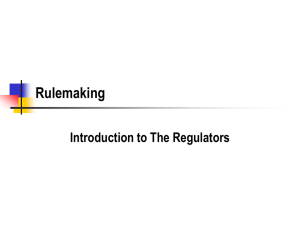Module 18 - Introduction to Rulemaking
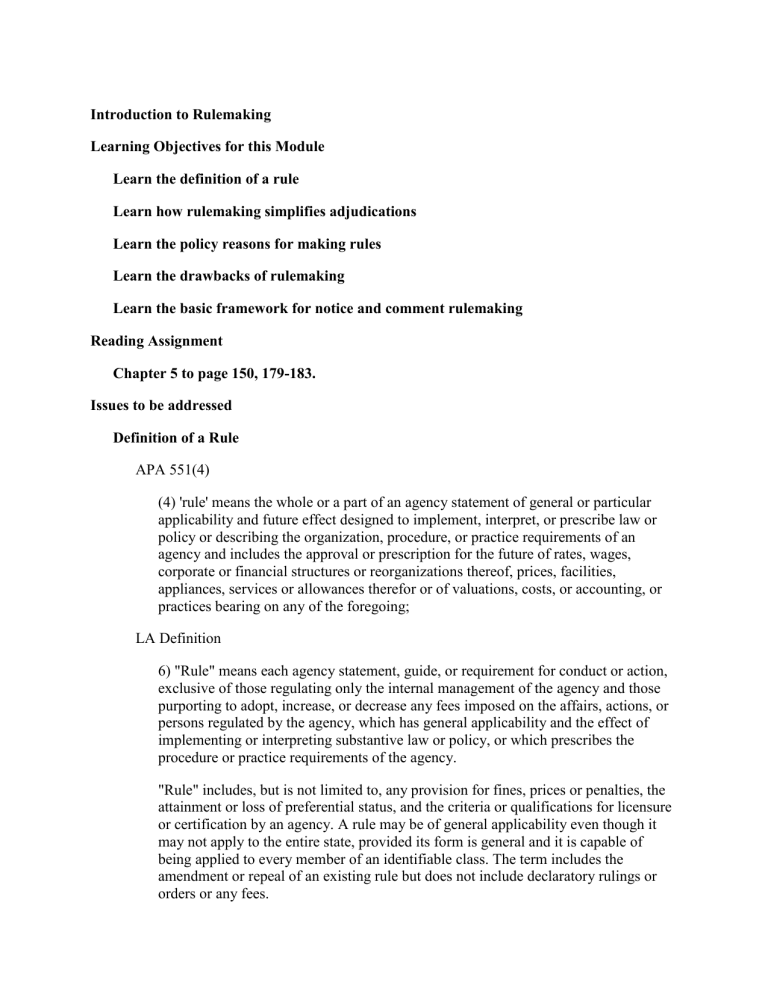
Introduction to Rulemaking
Learning Objectives for this Module
Learn the definition of a rule
Learn how rulemaking simplifies adjudications
Learn the policy reasons for making rules
Learn the drawbacks of rulemaking
Learn the basic framework for notice and comment rulemaking
Reading Assignment
Chapter 5 to page 150, 179-183.
Issues to be addressed
Definition of a Rule
APA 551(4)
(4) 'rule' means the whole or a part of an agency statement of general or particular applicability and future effect designed to implement, interpret, or prescribe law or policy or describing the organization, procedure, or practice requirements of an agency and includes the approval or prescription for the future of rates, wages, corporate or financial structures or reorganizations thereof, prices, facilities, appliances, services or allowances therefor or of valuations, costs, or accounting, or practices bearing on any of the foregoing;
LA Definition
6) "Rule" means each agency statement, guide, or requirement for conduct or action, exclusive of those regulating only the internal management of the agency and those purporting to adopt, increase, or decrease any fees imposed on the affairs, actions, or persons regulated by the agency, which has general applicability and the effect of implementing or interpreting substantive law or policy, or which prescribes the procedure or practice requirements of the agency.
"Rule" includes, but is not limited to, any provision for fines, prices or penalties, the attainment or loss of preferential status, and the criteria or qualifications for licensure or certification by an agency. A rule may be of general applicability even though it may not apply to the entire state, provided its form is general and it is capable of being applied to every member of an identifiable class. The term includes the amendment or repeal of an existing rule but does not include declaratory rulings or orders or any fees.
A rule is legislation.
General applicability, as opposed to specific parties
Prospective
Binding on the agency as well as on the public
Jargon Alert
Rule, legislative rule, or regulation
They all mean the same thing
Has the same effect as a statute passed by the legislature
Non-Legislative rule
Has no legal effect, but shows what the agency thinks the law is
Many names - interpretive rule, guidelines, guidance document, anything but rule or regulation
The Power to Make Rules
The power to make rules must be delegated by the legislature.
If the enabling legislation (the legislation creating an agency) is silent, the agency cannot make rules
The delegation may be broad, allowing the agency great discretion, or very narrow.
We will look at the standards for reviewing this delegation later in the course
Must the Agency Make Rules?
If the agency has the power to make rules, it has the discretion on what rules to make and when to make them.
The legislature can put provisions in the agency legislation requiring that certain rules be made, and the timeframe for making them.
The Clean Air Act required rulemaking to flesh out detailed technical standards
Unless there is a legislative directive, it is difficult to get the courts to force an agency to make rules
Not impossible, as we will see latter.
Why Make Rules?
Many statutes have too little detail to be enforced without additional rules.
The Clean Air Act could not be enforced until the agency established allowable emissions levels for the major pollutants.
Rules can be used to tailor a statute to new circumstances.
Food sanitations regulations should have been revised when it was found that sprouts were a source of food borne illness.
Rules provide a chance for the for the public to participate in the regulatory process.
The agency can learn from the public’s concerns.
There is more buy in to the rule if the public has been allowed to participate.
Once promulgated, a rule is binding on every party, eliminating the need for a factual determination of the issue resolved by the rule.
Once an allowable level of sulfur dioxide is established, the agency only needs to show that the emissions exceeded the threshold.
Without the rule setting an emissions limit, the safe level of emission would have to be re-determined in each enforcement action.
In disability cases, rules can be used to establish what constitutes a disability, rather than making it as case by case determination.
Uniformity
Rules set up a general framework that treats all parties uniformly
Rules are the fairest way to make big regulatory changes
If the agency does not have rules, it can change enforcement policy from case to case, and is also at the mercy of judges to accept or reject agency standards
National standards can be adopted through agency rules, harmonizing practice across jurisdictions.
National building codes.
CDC guidelines on food sanitation.
Recommendations of the Advisory Committee on Immunization Practices.
This also saves the governmental entity the cost of independently establishing and
defending the standard during rulemaking.
Agency Oversight
You can control the outcome of rulemaking much easier than that of adjudications
Not dependent on ALJs (administrative law judges)
This especially important in LA
More input from across the agency
Input from the public as well
Allows oversight by the President through OIRA in the federal system.
The Politics of Rulemaking
Congress often dodges the hardest issues and leaves them to agency rulemaking
Most of these involve cost-benefit analysis
How do you trade off automobile safety with price and fuel efficiency?
Are you more worried about delaying the entry of new drugs or the about allowing the sale of a drug with dangerous side-effects?
Do you want cheap power at the cost of lots of asthma and the Grand Canyon full of smoke?
Downside of Rulemaking
Trials (adjudications) involving single parties can be more flexible in the individual cases
Adjudications are useful when you are not sure what the rule should be and need more info and a chance to experiment
Rules can be so abstract or overbroad that they are expensive or difficult to follow
Like statutes
Agencies can promulgate rules that Congress would never pass - Green House Gas
Regulations.
Rulemaking Ossification
The courts and legislatures have increased the burden on rulemaking, especially in states
Rulemaking has gotten so complex and time consuming it has lost some of its value
Complicated by regulatory conflict and incompetent agency practice
Rulemaking can go on for years
What is the legal value of a proposed rule that has not been finalized?
The Medicare anti-kickback regulations were delayed for years between the proposed rule and the final rule
APA Informal (Notice-and-Comment) Rulemaking
APA 553 http://biotech.law.lsu.edu/Courses/study_aids/adlaw/553.htm
The proposed rule must be posted in the Federal Register (Louisiana Register), along with the statement of legal authority and other supporting information.
Electronic Notice is also given, but the official notice is still the notice in the register. http://www.regulations.gov
The public is allowed to submit written comments (email as well).
Public participation has great political benefit in broadening the acceptability of the rules.
Public comments can identify technical and legal problems with the rules
Publication of proposed rules allows politicians to become involved to protect the interests of their constituents
Public participation limits executive power and makes it more palatable to the courts to have agencies making laws
While the agency may take comments at public hearings, it is usually done in writing.
The agency must consider and answer the comments by class.
The rule may be re-proposed with a new comment period if extensive changes are made in response to the comments.
The final rule may be changed from original rule without additional comments if the change is a logical extension of the original rule. (Discussed latter)
Once a rule has been properly promulgated through notice and comment, it can only be attacked by attacking the published basis for the rule, and that must be done relatively soon after promulgation.
Evaluation Questions
There are no evaluation questions for this introduction.
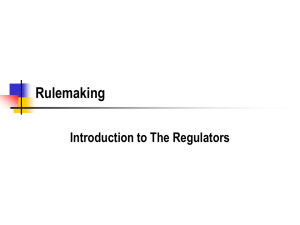
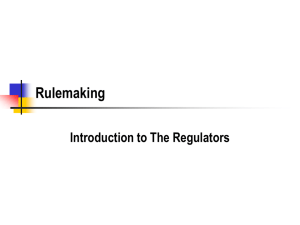
![Minnesota Department of [Name] MEMORANDUM](http://s2.studylib.net/store/data/015049440_1-475d22d0ab7bd661c71329dec0ae8429-300x300.png)
